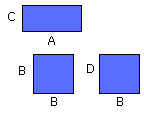If three straight lines be proportional, the rectangle contained by the extremes is equal to the square on the mean; and, if the rectangle contained by the extremes be equal to the square on the mean, the three straight lines will be proportional.
 Let the three straight lines A, B, C be proportional, so that, as A is to B,
so is B to C;
Let the three straight lines A, B, C be proportional, so that, as A is to B,
so is B to C;
 I say that the rectangle contained by A, C is equal to the square on B.
I say that the rectangle contained by A, C is equal to the square on B.
 Let D be made equal to B.
Let D be made equal to B.
 Then, since, as A is to B, so is B to C, and B is equal to D, therefore, as A
is to B, so is D to C.
Then, since, as A is to B, so is B to C, and B is equal to D, therefore, as A
is to B, so is D to C.
 But, if four straight lines be proportional, the rectangle contained by the
extremes is equal to the rectangle contained by the means.
But, if four straight lines be proportional, the rectangle contained by the
extremes is equal to the rectangle contained by the means.
 so is B to C.
For, with the same construction, since the rectangle A, C is equal to the
square on B, while the square on B is the rectangle B, D, for B is equal to D,
therefore the rectangle A, C is equal to the rectangle B, D.
so is B to C.
For, with the same construction, since the rectangle A, C is equal to the
square on B, while the square on B is the rectangle B, D, for B is equal to D,
therefore the rectangle A, C is equal to the rectangle B, D.
 But, if the rectangle contained by the extremes be equal to that contained by
the means, the four straight lines are proportional.
Therefore, as A is to B, so is D to C.
But, if the rectangle contained by the extremes be equal to that contained by
the means, the four straight lines are proportional.
Therefore, as A is to B, so is D to C.
 But B is equal to D; therefore, as A is to B, so is B to C
But B is equal to D; therefore, as A is to B, so is B to C
Therefore, etc.
Q.E.D.